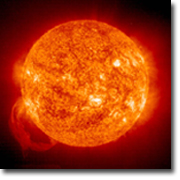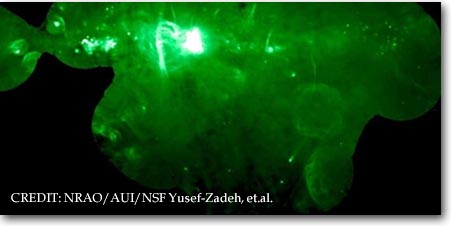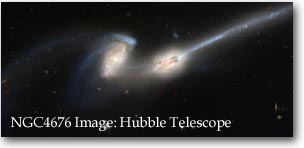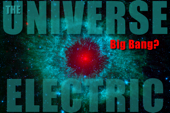
home • thunderblogs • forum • picture of the day • resources • team • updates • contact us
Dark Inertia - Part One02/16/08 Out of Nothing at All
Cosmologists credit Lambda-Cold Dark Matter with causing this structure and call the result the "concordance model", or the "standard model". It attempts to explain the history and shape of the universe. As opposed to discovering aspects of the universe through observations and measurements from experiments, the assumptions of this model are superimposed on the universe. When 'ugly facts', like the massive hole discovered in space surprise it's proponents (yet again) the theory simply 'morphs' to accommodate or minimizes such evidence altogether in order to survive. Like the good doctor's creation, it is a Frankenstein monster composed of various ill-fitting parts. According to traditional astrophysics the formation and evolution of spiral galaxies stem from small fluctuations or "ripples" in a uniform primordial plasma shortly after the big bang some 13.7 billion years ago. They, not only believe that the 'stuff' of the universe was originally smooth (homogeneous) and evenly distributed everywhere, but also that the cosmic microwave background radiation is a "relic" of this once smooth state. However, contrary to original assumptions, the universe forms "Great walls" and "sheets" of galaxies as opposed to being evenly distributed. The disparity between the observed 'clumpy' distribution of matter and light on large scales covering billions of light years, versus the relatively smooth portrait of the cosmic microwave background radiation, presents a problem for the big bang model as it attempts to account for these discrepancies. In their scenario, in the beginning, "dark matter" and "gas" began to condense via gravity through a process called "accretion". Smaller galaxies then merged to form larger ones, increasing the resulting galaxy's mass. Supposedly, the "gas" eventually contracted with increasing rotation speed until a flat disk was formed with "dark matter" staying outside of the disk. However, it is not clear how accretion occurs in an expanding universe and against centrifugal forces. One would think it obvious that such ad hoc assumptions are a 'force fit' onto observations contrary to the theory. The plasma universe has long recognized that different properties of plasma, such as temperature, density, chemical composition etc, can form such distinct 'cellular' regions throughout space. Such 'lumpiness' is a natural self organizing characteristic of plasma requiring no recourse to quantum "ripples" in a hypothetical primordial soup at 10-43 seconds after an explosion out of nothing at all. Intersections Based on the empirical results from plasma physics laboratories the Electric Universe posits a different hypothesis of galaxy formation. It assigns no 'beginning age' to the universe. Galaxies are not 'objects floating in space' but form as a result of highly energetic large scale Birkeland currents. Birkeland currents are far more effective scavengers of gas and dust than is gravity since their magnetic force falls off slowly with distance from the filament rather than rapidly (with the square of the distance) from a gravitating center. A plasma "sump" is formed between the filaments and populates the central bulge of the Milky Way galaxy, as seen below.
These dark plasma clouds, seen at lower right in the above image, are an important aspect of the plasma universe. Defining the 'edge' of the clouds is what's known as a ’double layer‘ (DL), two thin parallel layers of opposite electrical charge. They form the outer 'skin' or 'cell wall' boundary between plasma of opposing electrical charge. In the above photo the characteristics of the plasma in the dark interstellar clouds is different from that of their galactic environment and a DL forms to separate such distinct plasma regions. The entire change in voltage (voltage drop) between the two plasma environments occurs across the double layer.
Without the ad hoc invocation of small scale "fluctuations" in a primordial past shortly after the hypothetical big bang the standard model cannot explain the existence of plasma clouds. It has been generally agreed upon that the observable universe is 99.999% in a plasma state but unlike a gas, plasma naturally conducts electricity. In the early 1900's, after several explorations to the arctic, Kristian Birkeland proposed that the existence of such electric currents between the Sun and the Earth cause of the aurora. Now known as Birkeland currents or Field Aligned currents, the existence of filamentary electric currents in space has been verified by both the TRIAD and THEMIS missions.
In space large scale Birkeland currents can extend to unimaginable lengths:
The universe has been proven to be electrically active. In light of this fact it is a natural scientific progression for Electric Universe theory to then form the hypothesis that the same principles that are verified in plasma labs are operative on larger scales. Following the rampant speculation and unverifiable assumptions in the standard model, we need to acknowledge the combination of ubiquitous plasma, pervasive electricity and electromagnetism as prime causative agents of celestial dynamics. This becomes a necessity for modern astrophysics in light of the following: The inference of Dark Matter Normally with gravity, as one moves away from a gravitational center, orbital velocity decreases. Pluto orbits much more slowly than Earth for example because Earth is closer to the gravitational influence of the sun. Most of the gravity of a galaxy was thought to originate in the galactic bulge. The orbital velocity as one moves out from the center of a galaxy cannot be explained this way. The Newtonian law does not apply. Fritz Zwicky (1898-1974) first noticed this problem while studying the Coma galaxy cluster. Based upon the amount of visible mass in the Coma galaxy cluster there was simply too little gravity to account for orbital speeds. So the assumption was that there had to be more mass than was visible. He thus considered the "missing mass" to be "dark". Later, Vera Rubin discovered that most stars in spiral galaxies orbit the galaxy like a rigid disk. Hence the problem of "galaxy rotation curves". In this case too the inference was that there must be 'missing mass' extending gravity's influence. Again, according to the law of gravity, the farther from center an object is; the slower it's orbital speed. Much to the confusion of astrophysicists, galaxies apparently don't know this rule. The problem is easy to see. The assumption of gravitational mechanics, when applied to galaxies, necessitated the creation of something to uphold Newton's law. But maybe the law is inappropriate for this situation. Or possibly we don't understand the law as well as we might. If ever there were a time for a "new look at the physics", this is it. Instead, the inertia of consensus allowed "dark matter" to become a 'fact' instead of unfalsifiable conjecture.
In the electric universe galaxies are interacting formations of plasma, shaped by electric currents and their resulting magnetic fields. Their rotation is driven by the spiraling cosmic Birkeland currents. Following the evolutionary path shown by Anthony Peratt's supercomputer simulation, Birkeland currents will draw diffuse intergalactic plasma together to produce an elliptical galaxy in a central 'sump.' Peratt's particle-in-cell simulation does not show the central elliptical 'sump.' Instead we see the two Birkeland current filaments in cross-section. The Birkeland currents are attracted to each other via a relationship that produces long-range attraction and short-range repulsion. Meaning that, once the Birkeland currents are attracted to each other they will never actually touch. Instead they will spiral around each other and form a helical twisted pair.
Therein lies the solution to the apparent mystery of "galaxy rotation curves". Unlike the standard model, Electric Universe theory neither conjures up nor relies upon fictitious "dark matter" to fill in the gaps when electric plasma can well account for observed phenomena. Galaxies are not There is more supportive evidence still being acquired from electric plasma studies today such as those of the University of California, San Diego's Nonneutral Plasmas group with their studies of pure electron plasma "vortex mergers" amongst many others.
Permalink to this article.
Public comment may be made on this article on the
|

Solar is a regular contributor to the Thunderbolts Forum and a keen amateur astronomer. My Archives Chronological Archives Archives by Author Archives by Subject Thunderblogs home
|
|||||||||||||||||||||||||||||||||||||||||||||||||||||||||||
the material, and do not necessarily reflect the views of the Thunderbolts Project.
The linking to material off-site in no way endorses such material and the Thunderbolts
Project has no control of nor takes any responsibility for any content on linked sites.
home • thunderblogs • forum • picture of the day • resources • team • updates • contact us




